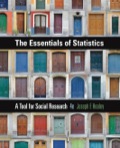
Concept explainers
SOC The table that follows reports the marital status of 20 respondents in two different apartment complexes. (HINT: As you solve these problems, make sure that you have the correct numbers in the numerator and the denominator. For example, problem 2.1a asks for “the percentage of respondents in each complex who are married,” and the denominators will be 20 for these two fractions. Problem 2.1d, on the other hand, asks for the “percentage of the single respondents who live in Complex B,” and the denominator for this fraction will be 4 + 6, or 10.)
| Status | Complex A | Complex B |
| Married | 5 | 10 |
| Unmarried (“living together”) | 8 | 2 |
| Single | 4 | 6 |
| Separated | 2 | 1 |
| Widowed | 0 | 1 |
| Divorced | 1 | 0 |
| 20 | 20 |
a. What percentage of the respondents in each complex are married?
b. What is the ratio of single to married respondents at each complex?
c. What proportion of the residents of each complex are widowed?
d. What percentage of the single respondents lives in Complex B?
e. What is the ratio of the “unmarried/living together” to the “married” at each complex?
a)
To find:
The percentages of the respondents in each complex are married.
Answer to Problem 2.1P
Solution:
Complex A:
Complex B:
Explanation of Solution
Formula:
Percentage: % =
Where,
f = frequency, or the number of cases in a specific category.
N = the number of cases in all categories.
For complex A,
The frequency of married respondents is f = 5.
Total number of frequencies is N = 20.
Therefore the percentage of the respondents who are married at,
Complex A:
For complex B,
The frequency of married respondents is f = 10.
Total number of frequencies is N = 20.
Therefore the percentage of the respondents who are married at,
Complex B:
b)
To find:
The ratio of single to married respondents at each complex.
Answer to Problem 2.1P
Solution:
Complex A: 4:5 = 0.80
Complex: B: 6:10 = 0.60
Explanation of Solution
Ratios are computed by dividing the frequency in one category by the frequency in another one. The formula for a ratio is:
Ratio =
Where,
For Complex A,
Therefore, the ratio of single to married respondents at complex A is
For Complex B,
Therefore, the ratio of single to married respondents at complex B is
c)
To find:
The proportion of the residents of each complex who are widowed.
Answer to Problem 2.1P
Solution:
Complex A:
Complex B:
Explanation of Solution
Formula:
Proportion =
Where,
f = frequency, or the number of cases in a specific category.
N = the number of cases in all categories.
For Complex A,
f = the number of widows in Complex A, f = 0.
N = the number of cases in all categories, N = 20.
Therefore, the proportion of the residents of each complex who are widowed is
For Complex B,
f = the number of widows in Complex B, f = 1.
N = the number of cases in all categories, N = 20.
Therefore, the proportion of the residents of each complex who are widowed is
d)
To find:
The percentage of the single respondents living in Complex B.
Answer to Problem 2.1P
Solution:
Explanation of Solution
Formula:
Percentage: % =
Where,
f = frequency, or the number of cases in a specific category.
N = the number of cases in all categories.
For complex B,
The frequency of single respondents from Complex B is f = 6.
Total number of single respondents is N = 6 + 4 = 10.
Therefore the percentage of the single respondents living in Complex B is,
e)
To find:
The ratio of the “unmarried/living together” to the “married” at each complex.
Answer to Problem 2.1P
Solution:
Complex A: 8:5 = 1.60.
Complex: B: 2:10 = 0.20.
Explanation of Solution
Ratios are computed by dividing the frequency in one category by the frequency in another one. The formula for a ratio is:
Ratio =
Where,
For Complex A,
Therefore, the ratio of unmarried/living together to married respondents at complex A is:
For Complex B,
Therefore, the ratio of single to married respondents at complex B is
Want to see more full solutions like this?
Chapter 2 Solutions
Essentials Of Statistics
Additional Math Textbook Solutions
Statistics: Informed Decisions Using Data (5th Edition)
Elementary Statistics (Text Only)
Probability and Statistics for Engineering and the Sciences
Statistical Techniques in Business and Economics
Introduction to Statistical Quality Control
Elementary Statistics: A Step By Step Approach
- A commuter must travel from Ajax to Barrie and back every day. Four roads join the two cities. The commuter likes to vary the trip as much as posible, so she alwaysleaves and returns by different roads. In how many different ways can she make the round-trip?arrow_forwardOn a 40-question final exam in history the problems are split between true/false questions and multiple-choice problems in the ratio of 3 to 5. Find the number of each type of problem.arrow_forward
 Algebra: Structure And Method, Book 1AlgebraISBN:9780395977224Author:Richard G. Brown, Mary P. Dolciani, Robert H. Sorgenfrey, William L. ColePublisher:McDougal Littell
Algebra: Structure And Method, Book 1AlgebraISBN:9780395977224Author:Richard G. Brown, Mary P. Dolciani, Robert H. Sorgenfrey, William L. ColePublisher:McDougal Littell Algebra and Trigonometry (MindTap Course List)AlgebraISBN:9781305071742Author:James Stewart, Lothar Redlin, Saleem WatsonPublisher:Cengage Learning
Algebra and Trigonometry (MindTap Course List)AlgebraISBN:9781305071742Author:James Stewart, Lothar Redlin, Saleem WatsonPublisher:Cengage Learning Mathematics For Machine TechnologyAdvanced MathISBN:9781337798310Author:Peterson, John.Publisher:Cengage Learning,
Mathematics For Machine TechnologyAdvanced MathISBN:9781337798310Author:Peterson, John.Publisher:Cengage Learning, Intermediate AlgebraAlgebraISBN:9781285195728Author:Jerome E. Kaufmann, Karen L. SchwittersPublisher:Cengage Learning
Intermediate AlgebraAlgebraISBN:9781285195728Author:Jerome E. Kaufmann, Karen L. SchwittersPublisher:Cengage Learning Algebra for College StudentsAlgebraISBN:9781285195780Author:Jerome E. Kaufmann, Karen L. SchwittersPublisher:Cengage Learning
Algebra for College StudentsAlgebraISBN:9781285195780Author:Jerome E. Kaufmann, Karen L. SchwittersPublisher:Cengage Learning Linear Algebra: A Modern IntroductionAlgebraISBN:9781285463247Author:David PoolePublisher:Cengage Learning
Linear Algebra: A Modern IntroductionAlgebraISBN:9781285463247Author:David PoolePublisher:Cengage Learning





